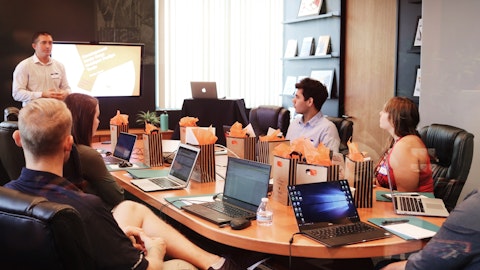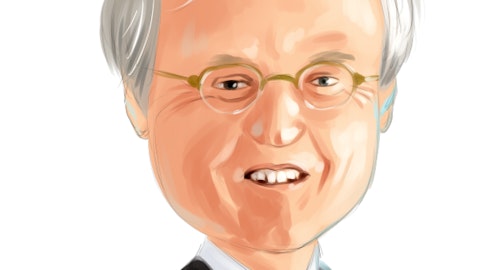Tim Brackney: Well, I’ll start. I think Kate can also add some commentary on this. But what I would say is that what we saw early on was that the Big 4 was much more aggressive in terms of raising their prices, and they were slower to lower them going through previous cycles. So, as a result, they have — their ability to kind of come down from those pricing — for that pricing if they’d like to price more aggressively, they can. Now, we haven’t really seen that yet. So, what I would say is that what we’re seeing in terms of opportunity is because they have — they still have enough demand in their pipeline that they can still price aggressively, there’s an ability for us to take on some of the work that they may have done from an execution standpoint and also for our ability to take over from where they’re — where they’re just kind of toeing the line on pricing, and we’re just simply a better value.
And we’re starting to see those opportunities now, particularly in some of those large clients.
Kate Duchene: Yes. Hi Mark, and Happy New Year, too. I’d answer it a little bit differently, too. What we’re seeing in the Big 4, and I’m hearing it directly from clients, is that they don’t have the talent or they’re experiencing quiet quitting in the delivery of the work for clients. So, I think the Big 4 are certainly having talent challenges that aren’t going away anytime soon. And the experience they’re delivering in the client base is an opportunity for us.
Mark Marcon: That’s really interesting. And it certainly sounds like a great opportunity for you. With regards to thinking strategically about your geographic footprint, how would you characterize the long-term opportunities in Asia Pac? How big could that practice be? And then similarly, how are you thinking about Europe? To what extent — is it macro versus the reorganization and the divestiture of taskforce, how — is that impacting the kind of the pipelines over there?
Kate Duchene: Yes. Let me jump in, and then I’ll have Tim follow up because I think he’ll have especially some further commentary on Europe. Let me start with taskforce, and then I’ll turn to Asia Pac. Taskforce, strategically, we are looking at building our business with an employed consultant model. We think that the importance of creating that connection and the global community of consulting talent is really important. And taskforce, if you remember, runs more of an independent contractor model. So strategically, we made that pivot, and I would say we’re very pleased that we’ve done that. And we wish taskforce well. There was no animosity with that separation. It’s just a different strategic vision of what we are building globally.
I just came back and so did Tim from trips in Asia Pac, and I think we’re both incredibly bullish about our opportunities there, especially throughout Southeast Asia, continuing to build in both, Manila and Bangalore and beyond Bangalore. The ability for us to tap into the right talent and to bring our model to that region, which is new for them, is exciting and, I think, exciting for all of us. I was really struck by how passionate our people are about our business model there and the ability to attract talent to what is a newer or emerging consulting model for that region. I think you’ll continue to see us. We’ve started that practice in Malaysia. There are some other geographies in Southeast Asia that we are looking at in a very cost-effective way.
But remember, too, the reason we’re investing in upgraded technology globally is that we want to be able to tap in and capture this borderless consulting talent without the cost structure of 10 years ago. And that’s what we’re prepping the Company for.
Tim Brackney: Yes. I mean, I’ll just add a couple of comments about APAC, and I just — I’ll make a quick note on Europe. In APAC, I think in addition to what Kate was talking about, a lot of the growth that we’ve seen has been centered around a similar strategy that we’re using in Europe, which is to try to attach our largest and most important clients in our strategic client account program globally. And so there are global initiatives where we would only play in certain work streams, and most of that was done domestically. And what we’ve seen over the last year in particular, and particularly in APAC, is that we — there are large opportunities for us there, opportunities to work in there — in centers of excellence over there, places where we have BPO and other setups.
And so, we’re taking advantage of that with our footprint. In terms of Europe, I think the one thing to remember, Mark, is that we restructured that with an eye toward profitability and making sure that we could service our large clients there. And as a result of that, our revenue base is a smaller client base, and we’re targeting more project execution projects, which will give us a little more volatility in terms of our run rate. But in the long term, as we continue to invest there, we’ll be able to kind of steady the run rate, and we’ll rightsize the business from a profitability standpoint.
Mark Marcon: Great. And then, can you give us any updates on HUGO?
Kate Duchene: Yes. HUGO is progressing as planned. We’re continuing to build talent pools in both the Tri-State and Southern California areas. I think the opportunity for us as we move into the second half of 2023 and beyond is how can we continue to leverage the capability of digital engagement more broadly in our business. I mean, this management team is very-focused on driving efficiency, lowering our cost of sales. And technology and digital engagement will be a piece of it. But so far, everything is going as planned. We don’t break it out separately. It’s not significant enough yet for us to focus on, but we’re very pleased with where we’re headed.



